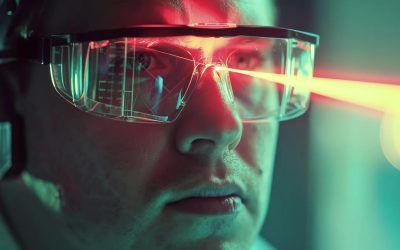Laser Hazards and Biological Effects: What You Need to Know
Laser Hazards and Biological Effects
Lasers are used everywhere—from cutting metal and performing surgery to light shows and research labs. But behind the precision and power is a complex web of biological risks. Understanding how lasers interact with the body—especially the eyes—is foundational to any laser safety program.
This article will walk you through how laser energy affects tissue, why the retina is especially vulnerable, and how thermal and photochemical effects play out at the cellular level. We’ll also break down how recent advancements in safety protocols are helping keep personnel safe across industries.
The Basics: What Makes Lasers Dangerous?
Let’s start with some fundamentals. Laser hazards are shaped by several key factors:
- Power and energy: Continuous-wave (CW) lasers deliver steady power; pulsed lasers deliver energy in bursts. Both can be hazardous.
- Wavelength: Certain wavelengths, especially in the 400–1400 nm range, can reach the retina and cause damage.
- Exposure time: Longer exposures mean more energy gets absorbed, which can increase both thermal and photochemical risks.
Thermal vs. Photochemical Effects: Know the Difference
Thermal effects happen when laser energy is absorbed and converted to heat. That heat can denature proteins, dehydrate tissues, and cause burns. We see this a lot in industrial laser cutting and some surgical applications.
Photochemical effects are more subtle—and often more dangerous over time. This happens when laser light triggers a chemical reaction in the body. UV and blue light are common culprits. These wavelengths interact with chromophores in cells and can generate reactive oxygen species (ROS) that damage DNA and cellular structures.
In many real-world situations, these effects can occur simultaneously, and even low-level exposures can have cumulative impacts.
The Retinal Hazard Zone: Your Eye’s Hidden Weak Spot
One of the biggest concerns in laser safety is protecting the eye—specifically, the retina. The eye naturally focuses incoming light onto a tiny spot on the retina, which amplifies the power density dramatically. That makes even a small laser beam potentially damaging.
- Wavelengths from 400 to 1400 nm are especially dangerous because they pass through the cornea and lens directly to the retina.
- Retinal pigment epithelium (RPE) cells are particularly susceptible to both thermal and photochemical damage.
- Even low-power lasers, like laser pointers, can cause lasting retinal burns under direct exposure.
Key safety takeaway: Always wear wavelength-specific laser eyewear when working with or near beam paths.
Photochemical Effects Up Close: What Happens at the Molecular Level
When laser photons hit a target, they can excite molecules inside your cells. This is particularly relevant in the blue to UV spectrum, where absorption is high.
- Cytochrome oxidase, melanin, and hemoglobin are common chromophores affected.
- Photochemical reactions often create free radicals and ROS, which lead to oxidative stress, inflammation, or even apoptosis (programmed cell death).
- Studies show that even small shifts in wavelength or pulse duration can dramatically alter the rate of cellular damage.
Key Point: Wavelength control, optical filtering, and time-based exposure limits are critical safety parameters.
Thermal Damage: Understanding Heat Transfer in Tissues
When tissue heats up rapidly from laser absorption, several things can happen:
- Proteins denature
- Collagen contracts
- Cell membranes rupture
- Water evaporates inside cells
This isn’t just theory. A single laser pulse can raise tissue temperatures by up to 15°C in milliseconds. That’s why managing heat—through cooling gels, pulse modulation, or infrared thermography—is standard practice in both industrial and clinical laser settings.
Pro tip: Spot size, pulse settings, and exposure duration all matter. Don’t overlook the physics when planning safety controls.
Real-World Data: What the Labs Are Telling Us
Recent studies show how photochemical and thermal effects often work together in damaging ways. Here are some takeaways:
| Mechanism | Observed Effect | Trigger Condition |
|---|---|---|
| Photochemical | 35% increase in ROS | 450 nm exposure in low-concentration cells |
| Thermal | Protein denaturation, 15°C temp rise | Short, high-power pulses |
| Combined | 50% boost in inflammation markers | Simultaneous photochemical & thermal input |
| Retinal Injury | Permanent damage at 5 mW | Direct ocular exposure |
The takeaway? Low levels of both hazards together can be worse than a high level of just one.
Prevention: How We Mitigate Laser Hazards
Laser safety is all about layers of defense. The more proactive the control measures, the lower the risk.
Engineering Controls:
- Beam enclosures
- Interlock systems
- Warning signs
- Thermal monitoring (e.g., IR thermography)
Administrative Controls:
- Standard operating procedures (SOPs)
- Laser safety training
- Access restrictions
Personal Protective Equipment (PPE):
- Laser safety eyewear (OD-rated for your system)
- Face shields for high-power setups
- Thermal filters when needed
Emerging Trends in Laser Safety
We’re seeing real innovation in this space:
- Smart eyewear that auto-darkens based on detected wavelengths
- Real-time beam monitoring using sensors and thermal cameras
- Adaptive beam shaping that adjusts output based on feedback from target tissue
Standards from ANSI and IEC are evolving to reflect these technologies, and risk assessments now consider more than just wattage and exposure time. Spectral range, pulse shape, and even individual eye characteristics are coming into play.
FAQs: Quick Answers for Laser Safety Officers
Q: What’s the most dangerous part of the eye when exposed to laser beams?
A: The retina—especially within the 400–1400 nm range where light is focused by the lens.
Q: Can low-powered lasers cause damage?
A: Yes. Even brief, direct exposure to Class 3R or 3B lasers can damage retinal cells.
Q: What’s the best way to monitor for thermal damage?
A: Use IR thermography and real-time power sensors to track tissue temperature and beam stability.
Q: How do you prevent photochemical damage?
A: Use wavelength-specific eyewear, apply exposure limits, and avoid UV/blue lasers without adequate filtering.
Final Thoughts
Laser hazards aren’t just a technical challenge—they’re a biological one. Understanding how laser energy interacts with tissue is the first step toward implementing safer protocols, protecting vision, and complying with regulations.
If you’re working in a high-risk environment, now’s the time to evaluate your laser safety program. Use real data, apply modern controls, and stay ahead of emerging hazards.




